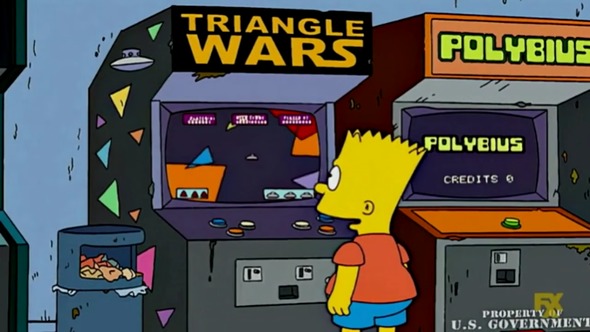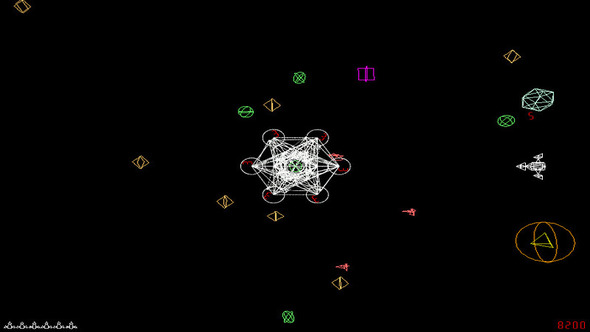Editor’s note: Jeff Minter’s Polybius is out now, but the origins of that mythical game go back decades, and venture to some dark places.
The Polybius story has everything. Shady government agents frequenting suburban arcades. A mysterious, untraceable European game developer, possibly operating under military contract. Mind control. Amnesia. Suicide. And in the middle of it all, an arcade game in an unmarked cabinet which, they say, showed up in the Malibu Grand Prix arcade in Beaverton, Oregon some time between 1979 and 1981 and caused quite a stir. It played a little like Tempest, but provoked strange and harmful – even fatal – reactions from its players.
Like coins? Get some Coin Master free spins while you’re here.
As Jeff Minter announces his own spin on Polybius for PlayStation VR, the myth demonstrates its significance even now, in 2016. It’s been a pet research project of mine for months, and what I find even more fascinating than the original urban legend are the impassioned and conflicting reports from Usenet posters and internet forumites that have moulded and transformed the nature of the tale for decades afterwards. Most disturbing of the subsequent unfolding drama comes with the involvement of a man named Steven Roach, at best an internet hoaxer, and at worst something much more nauseating. I thought I’d take the announcement of Polybius VR as my cue to share my interpretation of that ever-changing story.
Although the arcade cabinet itself is said to have first appeared at the Malibu Grand Prix arcade between 1979 and 1981, there are no written accounts of Polybius to be found before an archived Usenet post from 1994. Today even that post seems to have been lost under the landslide of the internet, so the earliest readable account comes from an archived clickto.com page from 2000. That in itself sounds the first alarm bell for rationalists, of course, but cutting the cord on conceivability here would ruin the fun, wouldn’t it?
“There were all kinds of strange stories about how kids who played it got amnesia afterwards,” writes the anonymous poster, “couldn’t remember their name or where they lived, etc.”
“The bizarre rumors about this game are that it was supposedly developed by some kind of weird military tech offshoot group, used some kind of proprietary behavior modification algorithms developed for the CIA or something, kids who played it woke up at night screaming, having horrible nightmares.”

There were mysterious visitors to the arcades that housed Polybius consoles too, claims the poster. Men dressed in black would come to collect “records” from the cabinets, according to an unnamed arcade operator. Never the quarters, just the records. According to Bitparade’s 2007 article on Polybius, which became famous for reasons I’ll go into momentarily, “there were even claims of suicides” resulting from exposure to the game.
An arcade game with shadowy origins and harmful effects, monitored by equally shadowy men. That’s the genus of the urban legend, comprised exclusively of anecdotal and unsubstantiated information. It requires an Olympian leap of faith to buy into the purported events themselves, but no such athletic feat to see how a story like this could have taken root in the early eighties.
Movies about arcade games with either magical powers or clandestine purposes are scattered throughout the early eighties. In 1983’s WarGames, Matthew Broderick unwittingly hacks into a US military supercomputer, believing it to be a videogame. That same year, Nightmares saw Emilio Estevez haunted by a game called The Bishop of Battle to the extent that he broke into an arcade in the middle of the night to complete it. 1984 saw the release of The Last Starfighter, in which a teenage boy is recruited by an alien race to do their bidding via an arcade game.

Polybius ‘sightings’ have been common through the years… as have their accompanying debunkings.
The new technology found in those teenage Meccas of bright lights and pocket change were capturing the wider imagination. And after a series of incidents in the Portland area specifically in which young players attempted days-long high-score marathons before submitting to muscle pains and gastrointestinal upsets, people were beginning to cast a suspicious eye on arcade gaming as well.
As Catherine Dispara reports in a 2012 article for Retrocade, “on November, 27, 1981, beginning at 11:00 am, 12-year old, Brian Mauro… blasted away at Asteroids over the Thanksgiving Day three-day weekend, in a bid to break the world record of 30.1 million previously set by 16-year-old Dennis Hernandez of Geneva, NY.”
It took Hernandez 52 hours and 11 minutes to set the record. Mauro lasted 28 hours before his physical discomfort became overwhelming. The incident’s especially pertinent to the Polybius urban legend, firstly because of its timing and location, but also because it tells us that people were only starting to learn that playing a videogame for several uninterrupted days at a time might be harmful to one’s health. Before that revelation sank in, you might explain the fact that an arcade cabinet had adversely affected someone’s memory, sleep patterns, or mental health using a more conspiratorial frame of reference.

The legend has a way of infiltrating pop culture without truly breaking into the mainstream.
The self-appointed fact-checkers have managed to throw out numerous claims that a photograph or primary witness confirms the whole story after all though. One of the more significant hits to the validity of Polybius came when it was revealed that the 2000 forum post was in fact authored by a notorious internet prankster with the handle CYBERYOGI. His real name’s Christian Oliver Windler, and that same year he posted this storyclaiming to have uncovered the lost ROM of another mythical arcade game called Phoenix. (Interesting aside: Windler is the founder of his own “reason-based” religion, LOGOLOGIE.)
Consensus among amateur Polybius investigators who reside in the ‘hoax’ camp is that Windler is the originator of the myth. Many people, myself included, have tried to reach him for comment; none have received a reply.
Most significantly, it was Windler who first made the claim that the game was produced by a company called Sinneslöschen, in German literally ‘senses delete.’ The construction of the word has been called into question by writer and fantastically thorough sceptic Brian Dunning as ‘not-quite-idiomatic German’ – in other words, not something that a German speaker would say – and that’s in turn been taken as supporting evidence by those who believe Windler was merely weaving an elaborate hoax.
Nevertheless, in 2006 a user named stevenroach came forward and left a post on the coinop.org forums claiming he had been an employee at Sinneslöschen during the development of Polybius. This is where the story moves from the realms of harmless urban legend into more sinister territory.
“I think it’s about time I laid this to rest,” Roach writes, “however entertaining the speculation. My name is Steven Roach who is primarily based in the Czech Republic. Sinneschlossen was a company set up by myself and several other mainly amateur programmers in 1978 that worked on component parts for Printed Circuit Boards that saw programming as a limited but very profitable sideline.”

Roach claimed that their fledgling studio was approached in 1980 by “a Southern American company that shall remain nameless for legal purposes” to develop a new kind of arcade game, featuring revolutionary graphics.
“Marek Vachousek was the programmer who came up with the name Polybius,” Roach continues. “He had studied Greek Mythology at Masaryk University and came up with the name because it sounded quite bold and mysterious, which is what we wanted quite simply.”
By combining raster and vector visuals – a claim that several programmers have fiercely disputed the possibility of – the team hit upon an addictive, innovative title, claims Roach. Sinneslöschen’s unnamed backers were hearted, and gave the game a limited release.
“But shortly after, we received terrible news – a 13-year-old boy from the Lloyd District of Portland, Oregon had suffered an epileptic fit while playing the game, only six days after the machines had literally been installed.”
People got nervous. Sinneslöschen and its financiers pulled the plug.
“Company Directors descended on the town to assess the situation which may account for these reports of ‘strange Men in Black Suits hanging around’ and the machines were often taken in daylight, causing minor but noticable [sic] incidents. As far as I was made aware, only seven machines were distributed around the area and no other health-related incidents were reported.”

Roach’s post is long, rambling, littered with typos and grammatical mistakes. It provides nothing that might convince a sceptic he did indeed work for Sinneslöschen, or even that the company or game ever existed. But for anyone with an eye on the myth beforehand, it must have been an irresistible dump of information to pick through.
One such individual was Duane Weatherall, who contacted Roach via the email address provided at the bottom of his forum post and conducted an interview via email in March 2007. “Here was just a simple post,” Weatherall tells me, “completely out of the blue and, if I recall correctly, it just just happened that I’d been reading up fairly heavily on Polybius at the time.”
As with CYBERYOGI, many people have tried to contact Roach following his assertions regarding Polybius – again, including myself – but only Weatherall received a reply.
“Everything was conducted via email,” says Weatherall, “and Roach seemed to be happy to answer anything I provided him with. I used a combination of things that I’d been wondering and I gathered a few questions from the users of the forum I’d ‘discovered’ him on.”
Weatherall probed Roach a bit deeper about who he was, why he came forward to tell his story, and what sort of game Polybius was. “What was the aim of the game? What went so wrong for the game to be pulled?”

Characteristic of the Polybius myth, there’s nothing in Roach’s statement or subsequent interview that conclusively proves or disproves his involvement, nor the existence of the game. But decades after the genus of the story, that doesn’t seem to be the point anymore. The interesting thing about Polybius isn’t the original tale, it’s the way it’s been proliferated and manipulated by the advent of the internet. As the medium matures, the increase in scepticism to each new claim is almost tangible. And at this point, in 2016, the most important aspect of it all is the identity of Steven Roach.
Weatherall didn’t know it at the time he conducted the interview, but in November 1998 a man by the name of Steven Roach and his wife Glenda were arrested in Brno, Czech Republic when it was discovered that the Morava School which they operated illegally imprisoned its students, violated their human rights and tortured them. There are numerous harrowing accounts of events at Morava provided by former detainees on a support network site, and many other from schools Steven and Glenda Roach operated across the world.
The appearance of that name in two such different places doesn’t tell us that the same man who ran a school that tortured children also developed Polybius, or even said he did. But it does tell us that Roach’s name, in conjunction with the Czech Republic (“I’m based in the Czech Republic where I’ve been living since the age of 15,” he told Weatherall), carries a certain connotation.
“If the Polybius Steven Roach and the Steven Roach from Moravia Academy are one and the same,” says Weatherall,” I can’t help feeling disgust at any man who abuses and tortures another human being, let alone a child. But I have no idea either way if the two are linked.”

Catherine DeSpira, author of that 2012 Retrocade article, is adamant that the two are one and the same. “There is one thing true in Steven Roach’s post,” she writes. “When he wrote the post, no doubt drawn to the subject of mind control he found so utterly seductive, he indeed had ties to the Czech Republic.
“In fact, he already had already been there. But he wasn’t a businessman. He had been the Security Director of a notorious ‘behavioral modification center’ for teens called Sunrise Beach, in Baja, Mexico, and yet another facility in the Czech Republic. And he was on the run from a reputation as a ‘dungeon master’.”
However, if DeSpira has evidence linking Roach the criminal to Roach the Polybius poster, she isn’t presenting any of it. “I know they’re the same guy,” she tells me when I ask. “There is a guy impersonating Roach, though… there’s actually a couple.”
As you hit a certain depth into the Polybius legend, you let go of the desire to prove or disprove it. Smarter people with more extensive research have burrowed incredibly deep down into the rabbit hole, but the simple fact of the matter is this: Polybius is too anecdotal to be effectively proven or disproven. If I tell you I went down the shops and bought a coffee on June 6, 1999, there’ll only be so much research you can gather before you hit a wall. The fact that you don’t have the data to confirm my claim means you’re not equipped to debunk it, either.
Polybius tells us more about the changing nature of fact and fiction in the internet era than it does about arcade culture in the ‘80s. It shows how easily the original story can be distorted, and how hard it is to get a definitive handle on that story again once it has. What might have begun as a response to a mystifying new technology and its harmful potential has now become, in equal parts, a game of telephone and an internet witch hunt. It seems impossible to imagine that we’ll ever reach a scientific conclusion on the legend, but it’ll be fascinating to watch it continue to evolve over the years.
